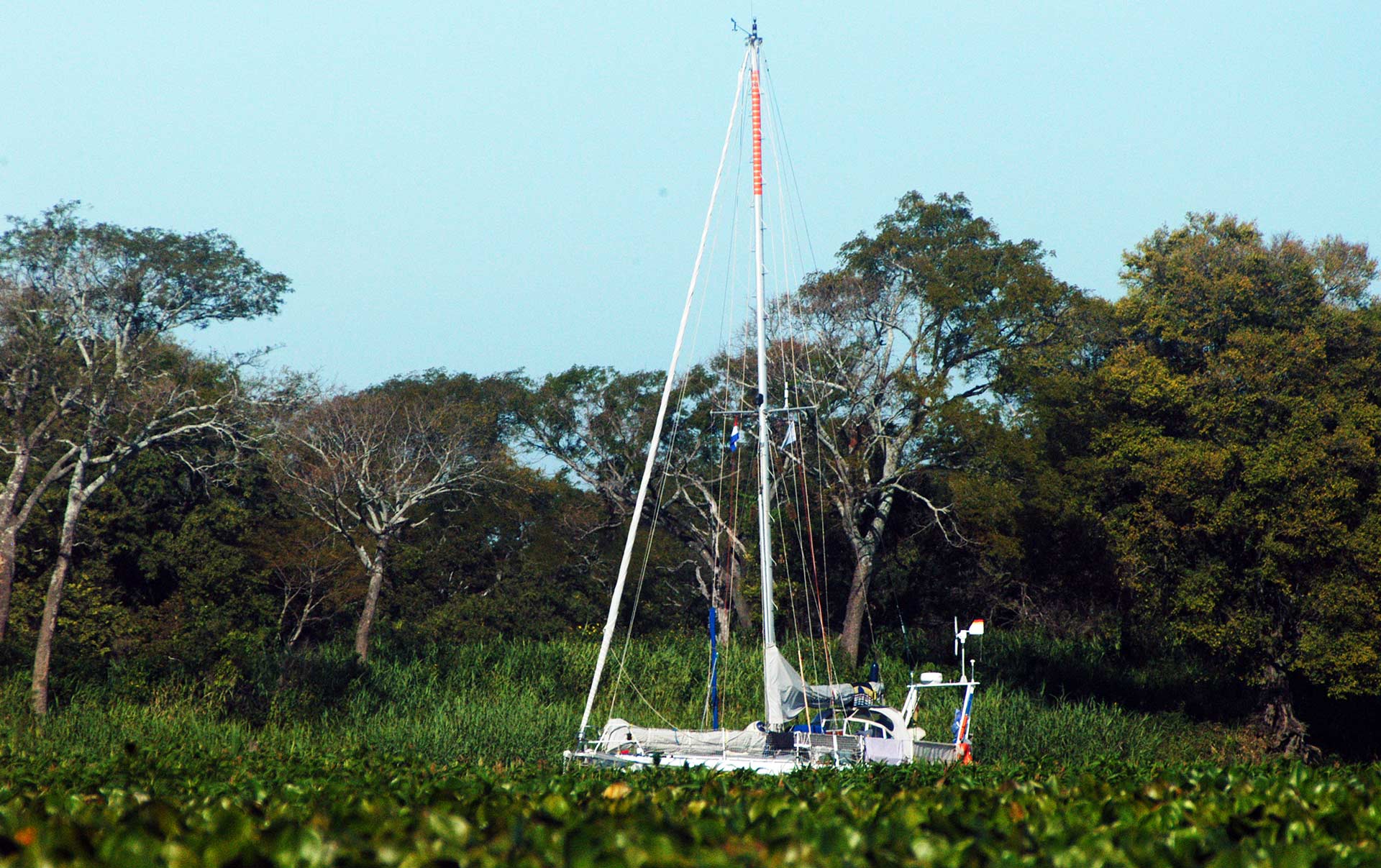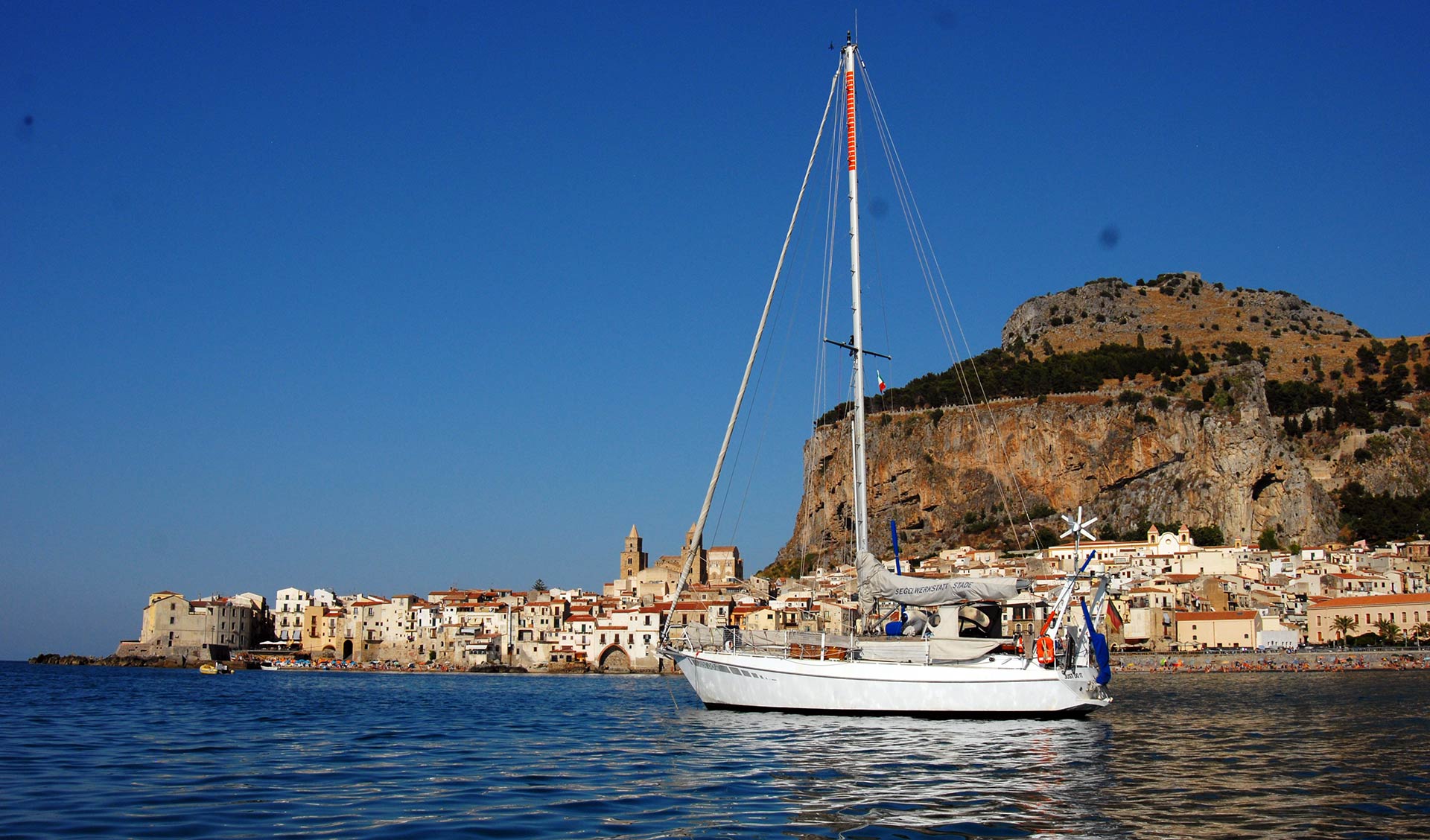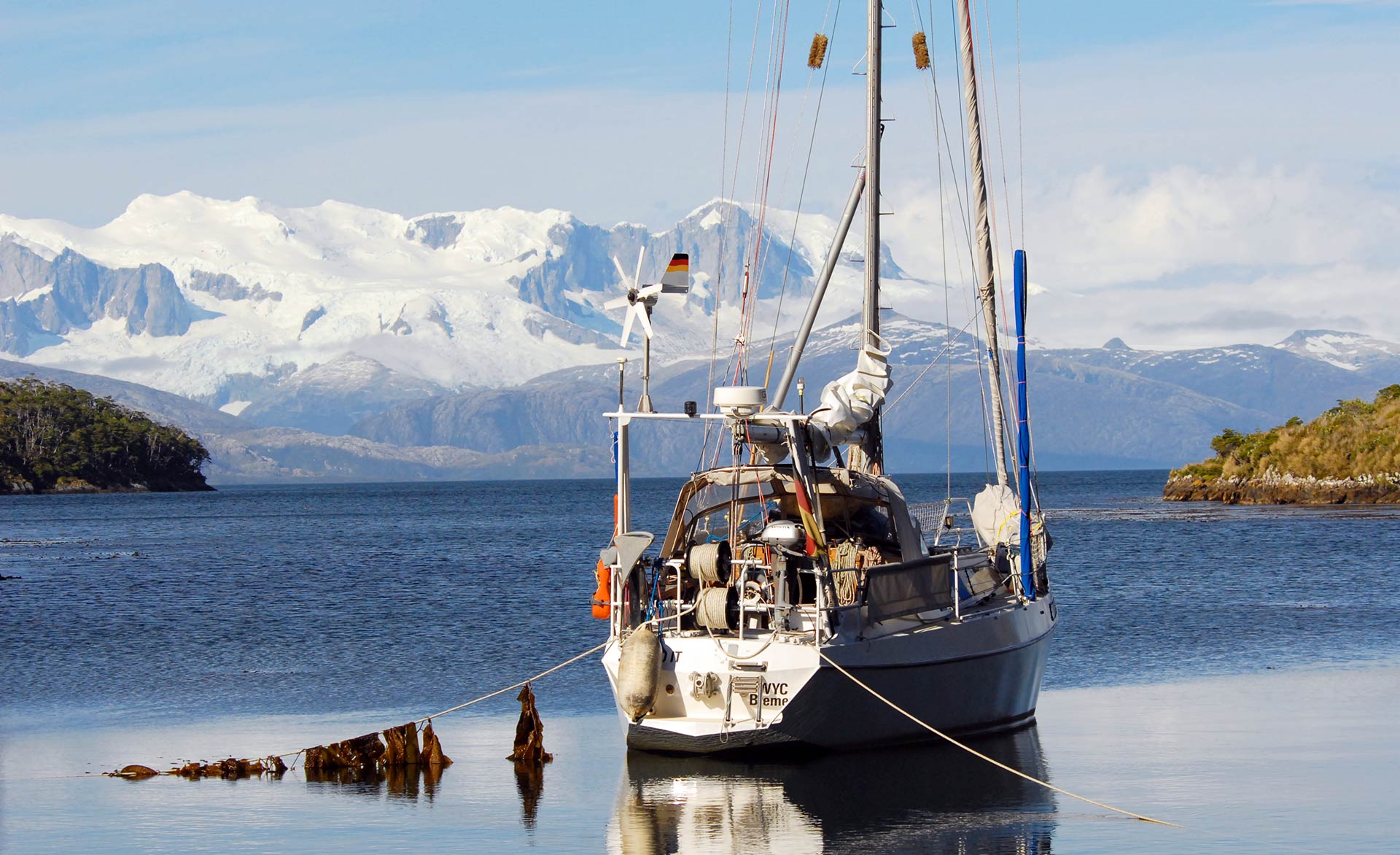It´s an excellent topic to spent hours debating: How does the perfect sailing yacht for the long haul look like? Her design? Her characteristics? What is important on the great loop, what is not? Safety first – versus speed and fun? How is comfort defined and what is expendable? What is necessary and what is not? I talked to Martin Birkhoff, chairman of the German chapter of Trans Ocean Organization about the perfect yacht for a world cruise.
“We provide helpful information for circumnavigators.”
NO FRILLS SAILING.com | Lars Reisberg: “Martin, it is good to have you here talking the perfect cruising yacht. I´m sure we will find the definitive boat for the circumnavigator …”
Martin Birkhoff: laughs “We won´t, I am sure. There are so many different views and opinions. But to look at this topic from different angles can be a good stimulus and raise questions or provide for answers the sailor normally wouldn´t have gone for.”
NFS.com: “At first: What is Trans Ocean Org and what is the purpose of this organization?”
Martin Birkhoff: “We have approximately 4.700 members at TO, which is quite a number. There is hardly a marina in the world where you won´t recognize our pennant hoisted on one or another yacht. Our purpose is the promotion of offshore cruising and offshore sailing sports. Which encompasses the whole range from sportive sailing, like races and other events, up to the more extreme sailing adventures where we grant for example financial support for those projects. Trans Ocean Org does maintain a worldwide net of bases in marinas and at home we offer a lot of workshops and the whole range of communication stuff like the website, a magazine, local meetings and alike.”

NFS.com: “Our topic today is the perfect cruising yacht. How urgently would you say is this question raised among sailors?”
Martin Birkhoff: “This is difficult to answer to. Because the yacht itself is just one factor among many which a sailor-to-be has to find an answer to. Besides, it´s up to the very sailor if the yacht is in question indeed: Some of them do already own a yacht and won´t be interested in talking about the boat itself because other topics have a far more urgent character for them. It depends on the ambitions of the sailor and his very project.”
NFS.com: “So this isn´t really among the top 5 of TO´s topics when sailors seek contact?”
Martin Birkhoff: “Rarely.”
“The perfect yacht for world cruising is a complex mixture.”
NFS.com: “Is there an official TO-recommendation how the perfect sailing yacht for, let´s say, a long circumnavigation should be equipped with, how she should be built and alike?”
Martin Birkhoff: “No, there is no official TO-opinion nor a recommendation on that particular topic. And I personally think that this isn´t possible – a sailing yacht is a complex mixture of many, many aspects. And every circumnavigation project itself is different from another one as well. So there can´t be given an official recommendation. Nevertheless, I do have my personal opinion on that one.“
NFS.com: “Please share it.”
Martin Birkhoff: “Well, for me, there are three main aspects to look at when going for a cruising yacht. That be safety, seakindness and seaworthiness. All of them do imply a list of things I would care for before casting off.”
NFS.com: “Let´s talk about safety at first. When looking at the very sailing yacht, what would be the main items to check on a list from your point of view?”
Martin Birkhoff: “For me, primarily safety offshore means to have a boat that features a relative safety (LINK safety concept) against capsizing. To capsize is a main hazard to yachts offshore on the great loop and I would look for a yacht that has a very high inert stability. Secondly, when talking about safety, I would also invest a great deal to find a yacht that bears a good protection against sinking. We are talking of ice and floating objects to run into. So in the end my yacht would be a boat with a thought through bulkhead-system to seal off damaged sections.”

NFS.com: “As a second point you´ve mentioned seakindness. Let´s go deeper into this.”
Martin Birkhoff: “Well, seakindness for me means to have a yacht that provides for a comfortable sailing experience. Through her hull design she will make it easier for the crew – above all in difficult conditions – to sail her safely and not to waste precious energy of the crew. A seakind yacht won´t consume the energy of the crew, it would rather provide a stable platform to preserve as much of it as possible.”
NFS.com: “Can you give examples?”
Martin Birkhoff: “For example the berths. It´s not really about their size or the cushion. For me, a good seagoing berth is defined by other aspects. For example a berth no one will fall out of or that the berth can be adjusted to the tack of the boat. Another example would be the galley that has to be operationable safely even in heavy weather conditions. I prefer saloon layouts which do not feature many free areas where it is hard to get a hold and the danger of a fall is imminent. Another one would be a good insulation against noise. The list is long …”
NFS.com: “Now let´s talk about seaworthiness.”
Martin Birkhoff: “Which is a seaworthy design from a technical point of view: That means that the yacht should be controllable very easily. It should feature straightforwardly operating equipment for the lines and above all for reefing the sails. This should be given at any point of sail. Furthermore, a yacht which from her design doesn´t require much work on the forecastle for obvious reasons. Safe passageways all over the deck area and a really important point would be the ascension to the boat from the water without external help.”
NFS.com: “Would you say that this picture of an ideal sailing yacht has changed very much over the years? The recent years maybe?”
Martin Birkhoff: “No, from my point of view because there isn´t a universal ideal. It´s up to each and every sailor himself.”
“There are so many details …”
NFS.com: “When we try to talk about the ideal yacht from Trans Ocean Org´s and your personal point of view, what would be the best hull material? Is there a general TO-recommendation?”
Martin Birkhoff: “It´s our point of view that a good yacht design will always consider the strengths and the limits of either material. If constructed this way there is no reason to exclude a particular material, be it timber, steel, GRP or aluminium alloy. Each of those materials will be suitable for making a hull if it is crafted properly by expert working and protected against the adversities of salt water. Steel may require a higher maintenance effort. Modern timber constructions are theoretically as easy-care as a hull made of aluminium alloy or GRP.”
NFS.com: “What would be the perfect size for a yacht. Or let´s put it this way: Where does a circumnavigation-ready yacht start from?”
Martin Birkhoff: “I would say that a yacht measuring 9 metres has the potential to sail around the world. Many have proven this. Everything smaller would be utterly uncomfortable, not just in heavy conditions. I would also say that a yacht bigger than 14, 15 metres could be too huge as the easiness of operating is decelerating. I should add that at this size a skipper will have to install more and more auxilary hardware such as electric winches or hydraulic installations which will make him dependent from technical stuff plus raise the risk of failure. So everything in between suits perfect, I would say.”
NFS.com: “What about the size of the engine and fuel tank capacity?”
Martin Birkhoff: “That´s also depending on the ambitions of the sailor. It´s clear that a considerable sizing of both engine and the amount of Diesel fuel on board will widen the range of the boat. Calms can be left behind quickly. Of course, a larger engine is also a safety feature as well.”

NFS.com: “What are from TO and your point of view indispensable pieces of equipment during a circumnavigation.”
Martin Birkhoff: “I would say that everything is dispensable. People get around the world with barely any equipment at all, just like in the good old times. If you ask me personally, the least expendable feature from a safety-wise position is AIS, EPIRB and a personal MOB-transponder attached to the life jacket. Comfort-wise I wouldn´t skip a good stove positioned where at the steadiest point inside the yacht and a basic cooling unit.”
NFS.com: “Let´s talk about canvas. Which sails, how many of them and what about spare parts?”
Martin Birkhoff: “Depending on the design of the particular rig and the type of boat of course I would say that you don´t need spare sails at all if you invest in canvas of high quality. Good sails can easily last a circumnavigation and longer. Besides, the big brands do have a worldwide service so that to nearly every spot in this world spare sails can be brought to. Considering storm sails I would advise not to choose too small storm sails because you need sail-area for keeping effectiveness. What a lot of sailors – from my experience – do underestimate and neglect is to carry a good and effective sail for light wind conditions like a Parasailor and alike. You need to have such a canvas that should be easily controllable single handed. When the course points to more barren areas of the world, a second main sail can be of advantage.”
NFS.com: “Speaking of expendable stuff on an oceangoing circumnavigating sailing yacht, what about all that electric stuff aboard? What do we truly need and what not?”
Martin Birkhoff: “If your approach to sailing is a minimal one, from my point of view all that you need to have on board is the electronics for navigation, like GPS, chart plotter, VHF-radio and of course the ship´s lights. A good one can be a satellite communication device like an Iridium phone because it can draw latest weather information. I would add that of course electric lighting and a simple cooling unit is a no brainer. To ensure charging of the batteries, you of course need a reliable energy source. Which can be a productive alternator powered by the Diesel engine of the yacht. Very effectively working offshore is a towed generator when underway.”
“Sailors who want to go around the world need to have an answer to multiple questions.”
NFS.com: “Let´s talk about your experiences with attempted, failed and of course successful round the world trips – what would you say are the most common reasons for failed circumnavigation-attempts?”
Martin Birkhoff: “That´s a range of problems. We´ve had people who simply didn´t had the right size of boat. Too small means a very tough sailing characteristic that will drain your energy, too big is tedious too. And besides, it´s expensive. We don´t have much problems with missing sailing experiences at all as long as the sailor keeps an ability to learn and grow underway. Very often on the other hand it´s ordinary problems with equipment: Sometimes they have it installed the wrong way or just impractical, sometimes it´s a sum of unpractical details. Often it´s the roping of course – rough-running lines draining power. We also have people who lose their life rafts because they haven´t fixed them properly, that can be a cause for a failure too. It´s diverse. A sailor should have a lot of answers to a lot of questions in such an undertaking.”
NFS.com: “So are there some kind of the 5 “golden rules” of circumnavigation in yachting?”
Martin Birkhoff: “No. Every project is a different one. Every sailor is a different one.”
NFS.com: “Let´s speak about the skipper himself. What is your – or the official TO-recommendation – for a fresh sailor. What would you say, when is it “right” to start such a project?”
Martin Birkhoff: “You cannot say that after such and such miles or after a handful of storms ridden out a sailor is qualified or something like that. I would say that personal qualities are the much more important ones, more important than sailing skills. You need to have a positive attitude towards life. Somebody who wants to do the great look because he is escaping something may have a hard time. Also, you need a lot of mental endurance, a talent for improvisation and of course the willingness to acquire technical knowledge and craftsmanship. Above all, a sailor like this should be open-minded, because the sea and a voyage on the seas will never turn out the way you think it would be.”

NFS.com: “What´s the official line in terms of sailing exams and certificates? What does TO recommend to have acquired at least?”
Martin Birkhoff: “That´s a bit embarrassing because I am not really familiar with certifications in that matter. Legally, the basic certification is enough to start a world-encompassing voyage. In Germany it´s the SBF-See and if you ask 10 people you will get 10 answers what more and what not more a young sailor should do to become a yachtmaster. I would say that all the rest is learning by doing. Because in the end it´s all about your experience – no matter which exams you passed and which not. But of course, it´s not a waste of time to acquire certifications. When we are talking about courses and seminars, I would strongly recommend “Survival at Sea” with an emphasis on leakage- and fire-control. And of course “Medicine on board” is also advised.”
“My ideal world cruising yacht would be the one ship that makes the most fun”
NFS.com: “If you´d had the chance to make a wish to Santa who will produce your personal perfect sailing yacht: What would she look like?”
Martin Birkhoff: “Definitely made of aluminium alloy, hard chined and equipped with a twin keel and one rudder blade. This yacht ought to be capable of settling on the bottom in tidal areas. Her draft should not exceed 1.50 metres. She will feature a moderate width with a relatively high freeboard. A center cockpit is my first choice. She is built in a light matter but will have a good handful of bulkheads. She is sloop-rigged with two tight consecutively mounted forestays. Above all – she is a guarantee to have fun!”

NFS.com: “Martin, it was such a pleasure talking to you. This is truly a topic worth tons of books and we could have talked admirably for hours. Thank you very much!“
Trans Ocean.Org is always looking for new, motivated members. If you are interested in joining the Organization, please browse to the Website: www.trans-ocean.org Furthermore, any donation will help the organization to keep up their great work.
Other related interesting articles:
What makes a yacht seaworthy?
What makes a good skipper?
Browse all #dreamyacht articles
All pictures in this article © Copyright by Martin Birkhoff
